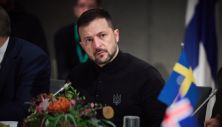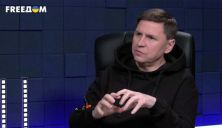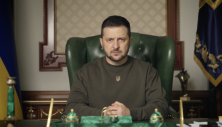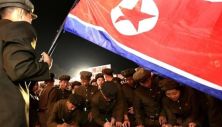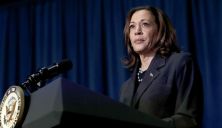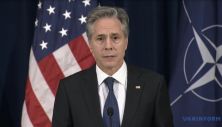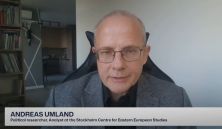President Volodymyr Zelenskyy said that there were no plans to seize nuclear power plants during the Kursk operation. The head of the Ukrainian...
Vous n'êtes pas connecté
- English
- Français
- عربي
- Español
- Deutsch
- Português
- русский язык
- Català
- Italiano
- Nederlands, Vlaams
- Norsk
- فارسی
- বাংলা
- اردو
- Azərbaycan dili
- Bahasa Indonesia
- Հայերեն
- Ελληνικά
- Bosanski jezik
- українська мова
- Íslenska
- Türkmen, Түркмен
- Türkçe
- Shqip
- Eesti keel
- magyar
- Қазақ тілі
- Kalaallisut ; kalaallit oqaasii
- Lietuvių kalba
- Latviešu valoda
- македонски јазик
- Монгол
- Bahasa Melayu ; بهاس ملايو
- ဗမာစာ
- Slovenščina
- тоҷикӣ ; toğikī ; تاجیکی
- ไทย
- O'zbek ; Ўзбек ; أۇزبېك
- Tiếng Việt
- ភាសាខ្មែរ
- རྫོང་ཁ
- Soomaaliga ; af Soomaali
Rubriques :
 Maroc - EURASIAREVIEW.COM - A la une - 17/Aug 10:52
Maroc - EURASIAREVIEW.COM - A la une - 17/Aug 10:52
US Has Ukraine’s Back In Kursk Incursion – OpEd
As the Ukrainian incursion into Russia’s Kursk Region rolls on, war conditions have appeared in Russia for the first time since the Second World War. It is a stunning experience that an estimated 180,000 people have become internally displaced. Ukrainian military was apparently gasping for breath, per Russian narrative. But Ukrainian mastery of combined arms warfare is on display and it is impressive — deploying everything from air defence to electronic warfare and armour and infantry. Ukraine made its point that it is capable of mounting a combined arms assault and bring some pain to Russians. The best spin that pro-Russian analysts could think of is that the Kremlin had set a trap actually so that Ukraine’s soldiers could once again be put into the meat grinder. It Is hogwash. It’s impossible to cover up the naked truth that Russian military has been caught with its pants down. Of course, Russians will eventually bring in enough forces to overwhelm the invading Ukrainians but it may take time as there’s no front-line. Kiev,which claims to be in control 1000 sq. km of Russian territory, says it isnot interested in “taking territory”but will continue its offensive until Moscow agrees to “a just peace.”But Ukrainehas set up a command centre inside Russia, hinting at prolonged occupation. Without doubt, this is a huge political and diplomatic setback for Russia and highlights that a Russian victory in Ukraine’s battlefields is not yet a foregone conclusion. That is not surprising, since this Clausewitzean war isabsoluter Krieg (‘pure war’) — “the collision of two living forces” — and, therefore, a complex of interactions, multi-layered and often unpredictable exists where goals of the warring states will be invariably influenced by the course of the war. Clausewitz wrote in his classic work On War that the complexity of actual war is evident in what he called a “remarkable trinity” of passion, reason and chance that underlie wars. The passion of war, he analysed,is the “primordial violence, hatred and enmity” that motivate people to fight; the reason of war is the calculation of means to achieve ends and the reckoning of costs and benefits; and, chance besets the whole enterprise. President Vladimir Putin’s demands for ending the war, as outlined in hishard-hitting speech at the Foreign Ministryin Moscow on June 14, possibly triggered this new phase of war starting on August 6. There is a lot of speculation regarding President Zelensky’s intentions. Pentagon Spokesman Patrick Ryder insists that Ukraine had not warned Washington in advance about its plans, but a Ukrainian official told Independent newspaper that “there were discussions between partner forces, just not on the public level.” Putin himself estimated that “theenemy, with thesupport from their Western backers, is executing their directives, andtheWest is using Ukrainians asproxies inthis conflict. It seems theopponent is aiming tostrengthen their negotiating position forthefuture.” Putin added that “these actions clearly aim toachieve aprimary military objective: tohalt theadvance ofour forces intheir effort tofully liberate theterritories oftheLugansk andDonetsk people’s republics, theNovorossiya region (read the former imperial Russian territory conquered from the Cossacks and the Ottomans comprising present-day eight oblasts of southeast Ukraine: Odessa, Mykolayiv, Kherson, Dnipropetrovsk, Zaporizhya, Kharkov, Donetsk, Luhansk.) Overall, Zelensky has challenged Putin’s concept of a ‘security zone’ beyond the frontline. Putin first spoke of it in March in a speech after winning re-election.The Kremlin spokesman Dmitry Peskov explained, “Against the backdrop of (Ukrainian) drone attacks and the shelling of our territory: public facilities, residential buildings, measures must be taken to secure these territories. They can only be secured by creating some kind of buffer zone so that any means that the enemy uses to strike us are out of range.” Putin himself justifiedlater — interestingly, during a visit to China — the launch of the Russian offensive on May 10 in Ukraine’s northeastern Kharkov Region insofar as Moscow aimed “to create a security zone, a sanitary zone. That’s what we are doing.” But Ukraine has since hijacked the Russian concept. Deputy Prime Minister and Minister for Reintegration of the Temporarily Occupied Territories, Iryna Vereshchuk announcedyesterday that the Ukrainian forces are creating a “security zone” inside Russia near the border with Ukraine so asto conduct humanitarian operations, open evacuation corridors (both in the direction of Russia and Ukraine) and allow international organisations to enter the conflict zone. Vereshchuk disclosed that relevant preparations and consultations are currently underway. Indeed, Farhan Haq, Deputy Spokesman for the UN Secretary-General told the media on Friday, “Well, certainly it’s a question of real concern that these developments are happening. We don’t have a presence on the ground in that region… we call for all concerned to act responsibly and ensure the protection of civilians. We would need more information about what is happening to understand exactly what the nature of the conflict in the Kursk region is.” Meanwhile, Zelensky also wrote on the social media yesterday, “Meeting on the situation in the Kursk region. We discussed key issues. Security, humanitarian aid, establishment of military commandant’s offices if necessary.” While Ukraine is internationalising its operations in the Kursk Region, on a parallel track, it is also expanding the operations to include the oblasts adjacent to Kursk. The big question is whether Moscow took its eyes off the ball and began daydreaming in recent months with seductive thoughts — Zelensky’s ‘readiness’ for talks; prospect of a Donald Trump presidency in the US; tensions (real or imaginary) between Washington and Kiev; expectations of Ukraine’s imminent collapse and so on.Whereas, the hard reality is that Crimea’s annexation and the Battle of Donbass remain unfinished business. Ukraine’s long-range drones reportedly hit four Russian airbases overnight on Aug. 14 in the largest attack on airfields in the war. As the summer months give way to autumn by October, the much vaunted Russian offensive to wrap up the war is nowhere in sight. Now that the Kremlin’s ‘red line’ on episodic Ukrainian drone attacks on Russian territory has been massively breached in Kursk with ‘boots on the ground’, what next? Indeed, Ukraine could be underestimating Russia’s numerical advantage in manpower and superior weaponry and the challenge of having to to redeploy units to mount and sustain the cross-border incursion as well as overstretched logistics is indeed daunting. On the other hand, the lame duck US president Joe Biden is an ‘X’ factor — an embittered man consumed by his own visceral hatred of Putin. He still has 5 months of absolute power, more than the time President Barack Obama needed to create a fait accompli in US-Russia relations for years to come. Ukraine is using weapons provided by Western governments, including the UK, US, and Germany, as part of its ongoing incursion into Russia. German and US armoured fighting vehicles, as well as UK tanks have been involved in Ukraine’s ground operation. This signals that the Kremlin’s verbal threats carry less and less weight in Western capitals. Ukraine may be punching above its weight to defend itself from Russia’s devastating glide bombs. But the fact remains that every time Putin mentions tactical nukes, it is still a message of deterrence. Ukraine’s audacious move to carry the war into Russian territory may well precipitate that nuclear moment. If crunch time comes, Biden may meet Russia’s use of tactical nukes with a conventional response (i.e. non-nuclear), which Russia risks losing. That may well be Biden’s game plan.
Articles similaires
Without a plan for victory, it is impossible to force Russia to fulfill the points of the peace formula, – Podolyak
The formula for peace and the plan for Ukraine's victory are processes that are impossible without each other. And without them, it will not be...
First North Korean troops expected to be deployed by Russia to combat zones on Oct 27–28 – Zelenskyy
President Volodymyr Zelenskyy has received a report from Commander-in-Chief of the Armed Forces of Ukraine Oleksandr Syrskyi, which includes...
N. Korean troops transported to front in trucks with civilian plates – Ukrainian intelligence
Russians are transporting North Korean mercenaries to the front lines in trucks with civilian license plates. This information was obtained...
Putin: Russian Military in Kursk Region Creates Ring of Encirclement of Ukraine's Forces
MOSCOW (Sputnik) - The Russian military in Russia's Kursk Region has created a reliable ring of encirclement of the Ukrainian armed forces and is now...
Vice President Kamala Harris believes that if Donald Trump were to win the presidency again, it would mean a victory for Russia in its war against Ukraine
The presidential candidate from the Democratic Party, the current Vice President of the USA Kamala Harris sees the risks that "Putin will sit in...
Blinken: 8,000 N. Korean soldiers in Kursk region could be deployed in combat soon
Approximately 8,000 North Korean troops are currently stationed in Russia's Kursk region and may be involved in combat operations against Ukraine in...
Blinken: 8,000 N. Korean soldiers in Kursk region could be deployed in combat soon
Approximately 8,000 North Korean troops are currently stationed in Russia's Kursk region and may be involved in combat operations against Ukraine in...
The complication of German politics in Russia-Ukraine war. Interview with Andreas Umland
The U.S. Pentagon chief went to Kyiv to announce more support for Ukraine amid the disturbing news of North Korean soldiers being deployed to...
How Could The Ukraine-Russia War End? – OpEd
The outcome of the Ukraine-Russia war hinges on a complex mix of military strategy, diplomatic negotiations, and the endurance of each side's...
Les derniers communiqués
-
Adobe Brings Conversational AI to Trillions of PDFs with the New AI Assistant in Reader and Acrobat
Adobe - 21/02/2024
-
Laura Frigenti takes the Helm as Chief Executive Officer of the Global Partnership for Education
Global Partnership for Education - 05/12/2022
